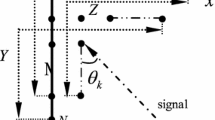Abstract
A new method is presented to effectively estimate the direction-of-arrival of a source signal and the phase error of a uniform linear array. Assuming that one sensor (except the reference one) has been calibrated, the proposed method appropriately reconstructs the data matrix and establishes a series of linear equations with respect to the unknown parameters through eigenvalue decomposition. The unknown parameters can be determined directly by the least squares method. Unlike the conventional methods, the proposed method only requires one calibrated sensor, which may not be consecutively spaced to the reference one. The computational complexity analysis is given and the effectiveness of the proposed method is validated by simulation results.






Similar content being viewed by others
References
Cao, S., Ye, Z., Xu, D., & Xu, X. (2013). A Hadamard product based method for DOA estimation and gain-phase error calibration. IEEE Transactions on Aerospace and Electronic Systems, 49, 1224–1233.
Friedlander, B., & Weiss, A.J. (1988) Eigenstructure methods for direction finding with sensor gain and phase uncertainties. In: International conference on acoustics, speech, and signal processing, ICASSP-88 (Vol. 5, pp. 2681–2684)
Golub, G. H., & Loan, C. F. V. (1996). Matrix computations. Baltimore, MD: The Johns Hopkins University Press.
Krim, H., & Viberg, M. (1996). Two decades of array signal processing research: The parametric approach. IEEE Signal Processing Magazine, 13, 67–94.
Liao, B., & Chan, S. C. (2012). Direction finding with partly calibrated uniform linear arrays. IEEE Transactions on Antennas and Propagation, 60, 922–929.
Liao, B., & Chan, S. C. (2015). Direction finding in partly calibrated uniform linear arrays with unknown gains and phases. IEEE Transactions on Aerospace and Electronic Systems, 51, 217–227.
Liao, B., Chan, S. C., Huang, L., & Guo, C. (2016). Iterative methods for subspace and doa estimation in nonuniform noise. IEEE Transactions on Signal Processing, 64, 3008–3020.
Liu, A., Liao, G. S., Zeng, C., Yang, Z., & Xu, Q. (2011). An eigenstructure method for estimating DOA and sensor gain-phase errors. IEEE Transactions on Signal Processing, 59, 5944–5956.
Ng, B. C., & See, C. M. S. (1996). Sensor-array calibration using a maximum-likelihood approach. IEEE Transactions on Antennas and Propagation, 44, 827–835.
Roy, R., & Kailath, T. (1989). ESPRIT-estimation of signal parameters via rotational invariance techniques. IEEE Transactions on Acoustics, Speech, and Signal Processing, 37, 984–995.
Schmidt, R. O. (1986). Multiple emitter location and signal parameter estimation. IEEE Transactions on Antennas and Propagation, 34, 276–280.
See, C. M. S., & Gershman, A. B. (2004). Direction-of-arrival estimation in partly calibrated subarray-based sensor arrays. IEEE Transactions on Signal Processing, 52, 329–338.
Weiss, A. J., & Gavish, M. (1991). Direction finding using ESPRIT with interpolated arrays. IEEE Transactions on Signal Processing, 39, 1473–1478.
Zhang, X., He, Z., Liao, B., Zhang, X., Cheng, Z., & Lu, Y. (2017). \(\text{ A }^\text{2 }\text{ RC }\): an accurate array response control algorithm for pattern synthesis. IEEE Transactions on Signal Processing, 65, 1810–1824.
Zhang, X., Liao, G., Zhu, S., Zeng, C., & Shu, Y. (2015). Geometry-information-aided efficient radial velocity estimation for moving target imaging and location based on radon transform. IEEE Transactions on Geoscience and Remote Sensing, 53, 1105–1117.
Author information
Authors and Affiliations
Corresponding author
Appendix
Appendix
The proof of (34).
(1)

where \(\begin{array}{*{20}{c}} r\\ {\widetilde{\quad \quad }} \end{array}\) and \(\begin{array}{*{20}{c}} c\\ {\widetilde{\quad \quad }} \end{array}\) denote elementary row operation and elementary column operation, respectively, and they does not change the rank of a matrix. From the analysis above, we conclude that

(2)

So, we have

(3)

We have

From the proof above, we can conclude that

This completes the proof.
Rights and permissions
About this article
Cite this article
Zhang, X., He, Z., Liao, B. et al. DOA and phase error estimation using one calibrated sensor in ULA. Multidim Syst Sign Process 29, 523–535 (2018). https://doi.org/10.1007/s11045-017-0484-x
Received:
Revised:
Accepted:
Published:
Issue Date:
DOI: https://doi.org/10.1007/s11045-017-0484-x




